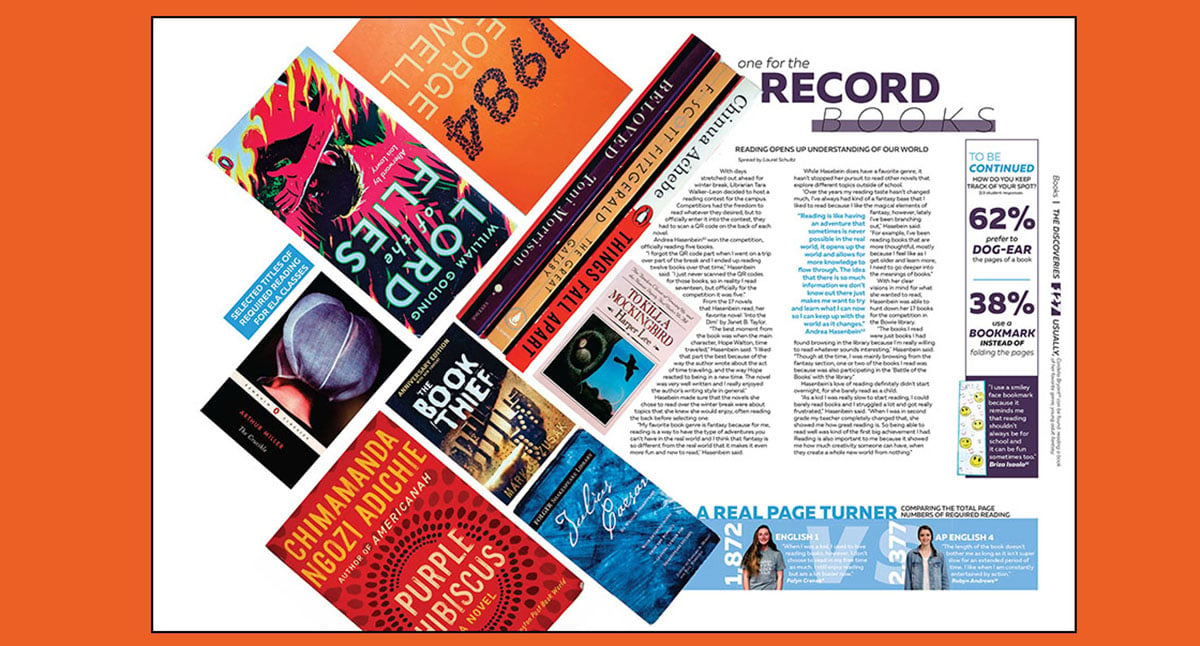
As the unusual school year continues, we’re all questioning how to focus on academics. Here are 20-plus ideas to make the grade. This is the first of a two-part tip on academic coverage.
21 for 21
1. One word – Include even the most reserved students with this simple, but effective module. Ask for one-word answers to school-related topics: first week, virtual learning, hybrid formats, in-person classes, Zoom, freshman year, senior year, etc. Use the one-word format on a single module or make it a recurring sidebar, featuring different topics each time. Or if you’re really adventurous, turn the one-word idea into an entire spread, a typographic layout utilizing various font treatments—weight, size and color for visual appeal.
2. In five words – Same idea, but expanded for a slightly longer answer. One popular method is to ask for answers via social media and use a hashtag like #BacktoSchoolin5words.
3. First day photos – Whether you were in-person or at home, capturing those first day moments are an important milestone, especially this year. Gather photos from porches and front doors and run an entire spread of them.
4. Work spaces – For all the virtual students, show off the home school setups. Feature desk settings, but also other popular work-from-home locales like couches, beds and outdoor spaces.

Desk setups, photo by Stacy Mehrens
5. School essentials – Pencils? Check. Calculator? Check. Backpack? Hmm, maybe not. Think about designing a lay flat spread, photographing and featuring all the necessary tools for the school day. Also, don’t forget those other items to survive the school day: digital devices, earbuds and go-to snacks.
6. Classroom changes – Illustrate how room setups have changed with social distancing measures. Consider also discussing the challenges with spacing, cleaning and connecting with students.
7. Teachers’ classrooms – Reminiscent of MTV’s Cribs, showcase your teachers’ second homes. Photograph classroom décor, the cozy touches and desk tchotchkes. Pay attention to the subtle touches to their content areas.
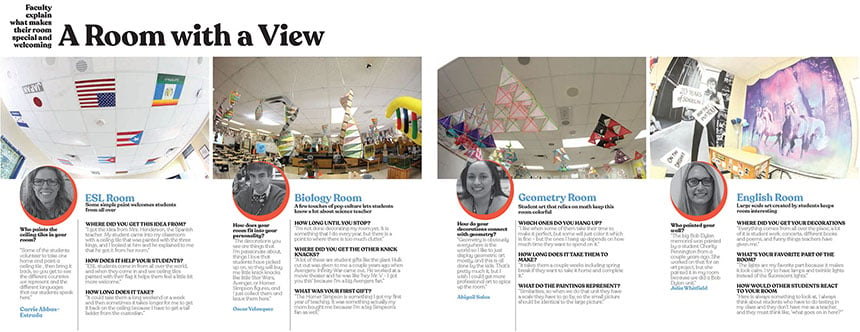
Teachers’ classrooms, Claudia Taylor Johnson High School, 2020
8. Match game – Add interactive coverage with a quiz matching favorite sayings to the corresponding teacher. Run the answers small, upside down or in the index.
9. Teaching challenges – Focus on the adult’s perspective on teaching in a pandemic. Talk to teachers about juggling virtual and in-person instruction, connecting with students and how they measure success.
10. Student challenges – Learning is also formidable in a pandemic. Consider a long-story format to feature different students’ stories or a text-only spread with quotes reflecting the difficulties.
11. Note-taking – Let’s show off notes taken, especially by students with easy-to-read handwriting. Consider creating a whole, showstopper spread on note-taking, or use as a module on a core classes spread.
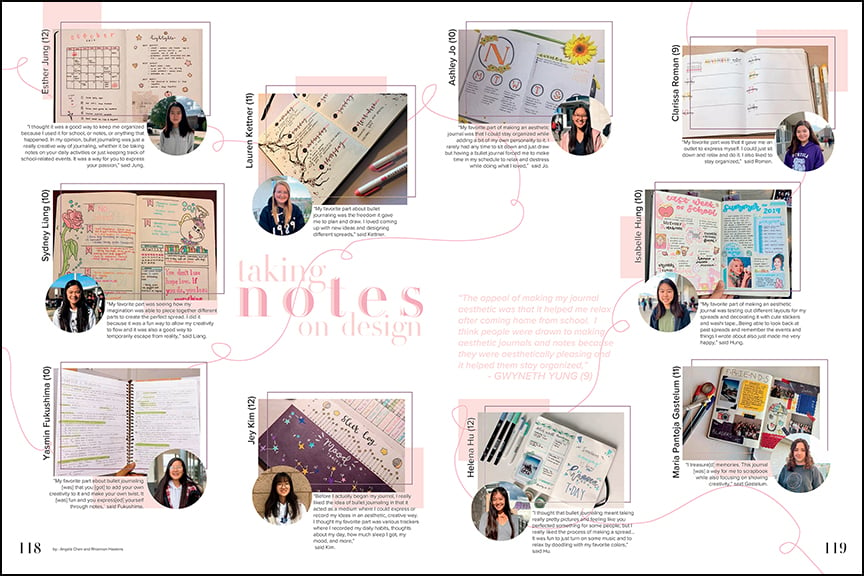
Note-taking, Portola High School, 2020
12. Studying – School is about more than what happens during the school day. Cover studying habits, favorite spots and late-night strategies.
13. DIY assignments – One of the most fascinating aspects of academic coverage is how classroom activities work from home. Capture how teachers are sending materials home and how those experiments, projects and assignments are turning out. Also, don’t forget about how career technology classes are teaching culinary, auto tech and welding skills, and how physical education classes are conducting fitness activities.
14. In-school assignments – For those back in person, focus on the lesson plans that involve active participation. Capture students conducting experiments, going to the board and creating artwork. Take advantage of outside classes for another photographic perspective.
15. Artist’s showcase – Regardless if you’re at home or in school, let’s celebrate student creativity. Dedicate a spread (or two or three) to the visuals arts: art, photography and digital graphic classes.
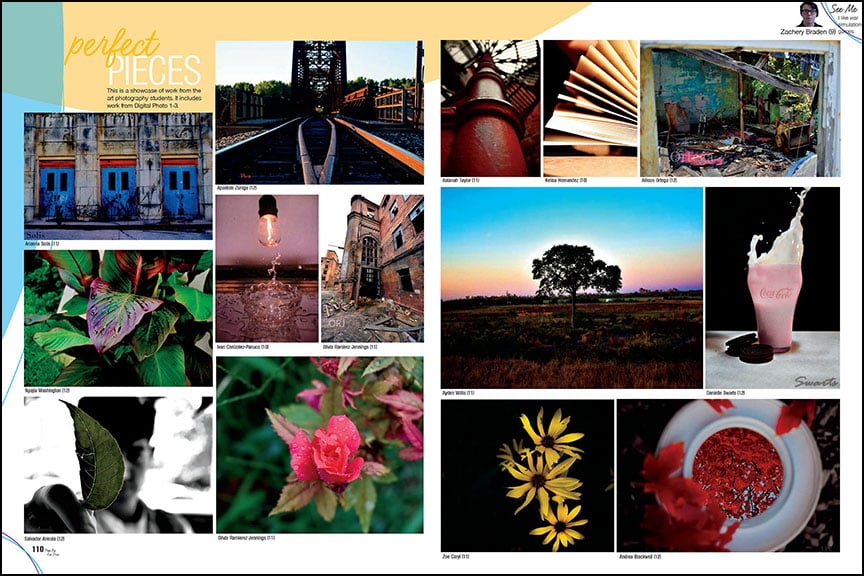
Photography, Topeka High School, 2020
16. In-person school experience – Back at school, how are classes different? Include the schedule if it’s been adjusted to accommodate for social distancing. Feature how learning is happening and discuss the changes, obstacles and any benefits.
17. Best books – Give the English classes some love with a spread dedicated to reading. Feature books from each grade level, using cutouts of the covers (if you’re in-person, it could be a stack of books; if virtual, try photographing each book separately and use that to your advantage in the design). Poll students on which book they liked or disliked the most, how long it took to read and how many relied on SparkNotes instead of the actual pages. Gather quotes for meaningful reflection—what they thought of the books, which ones they surprisingly liked, how they felt about the endings.
18. Cutout creativity – Instead of worrying about non-existent classroom pictures, be innovative with the visuals. Think creatively about what type of objects could represent classes, especially electives, and photograph those items for a spread. Think paint brushes, microscopes, books, iPads, calculators, etc.
19. School by the numbers – Collect all the interesting facts and figures about your school and use with cutouts, graphics or a compelling photo of the campus.
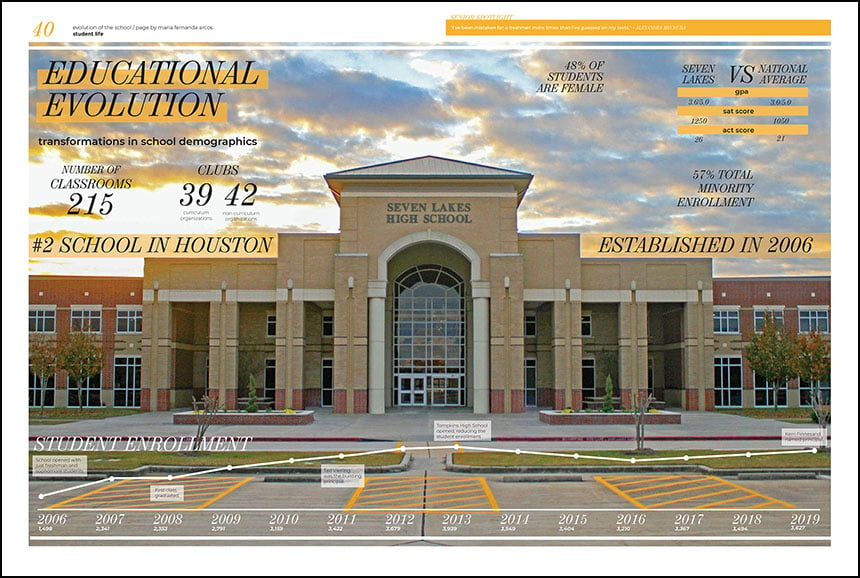
School stats, Seven Lakes High School, 2019
20. Early graduates – Feature students who opt to graduate early at the semester.
21. College choices – It’s not just about high school. Document the senior journey and what it takes to get into college. Photograph seniors in their future alma mater’s color. Don’t forget about seniors choosing a different route: trade schools, the military and gap years.
You may have noticed only a few of these ideas relate to specific classes. The traditional strategy of covering academics by subject may need to go by the wayside this year. Consider the above ideas for an approach that blends classes with a topical approach. In the end, you’ll share a fresh perspective in an unusual year.
Need to see more visuals? Check out our coverage page on the Balfour Exchange.
And don’t forget to check out the second part of this academic coverage tip, remote learning ideas and a four-page academic ideas handout with all the ideas in one place.

